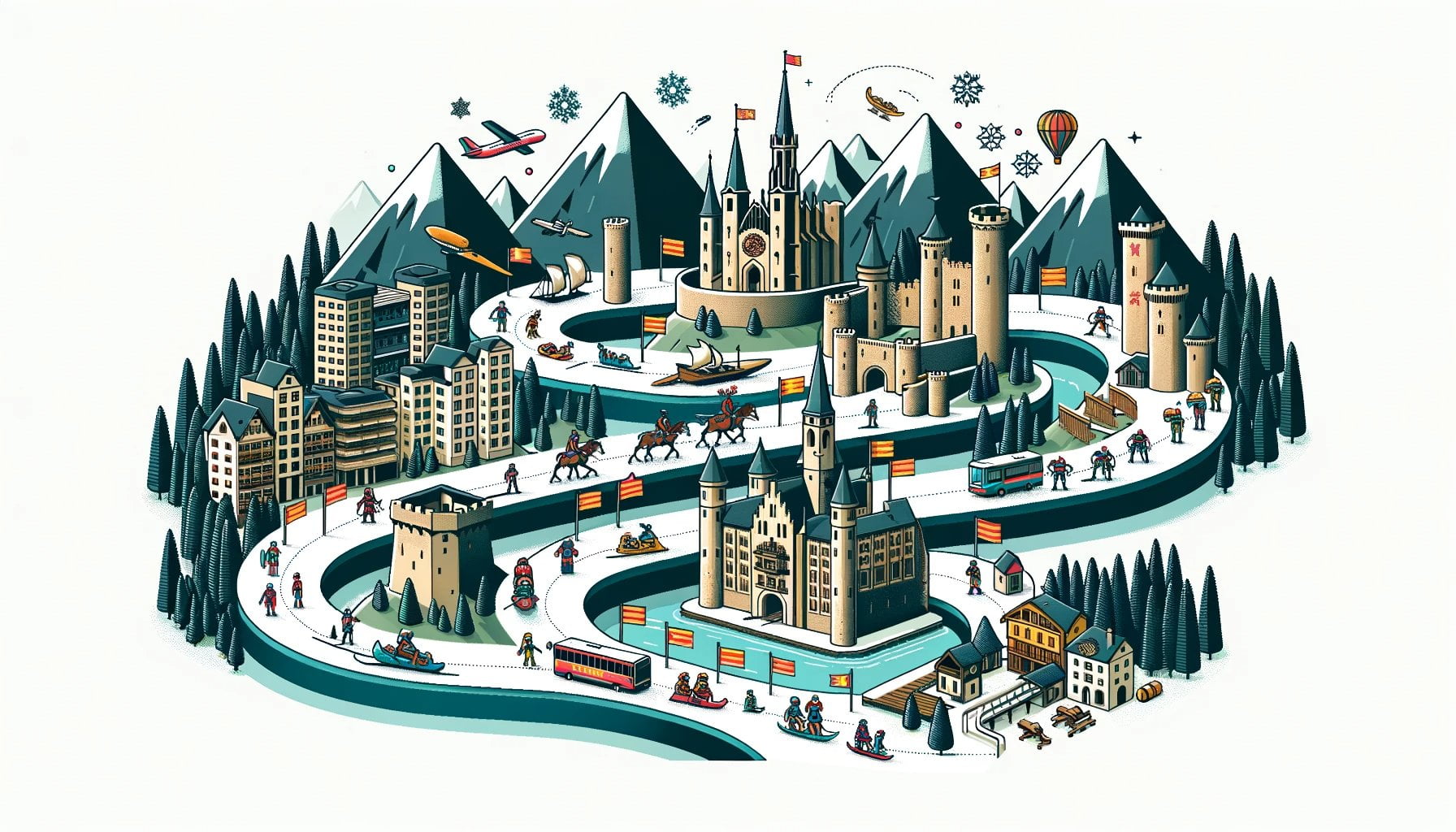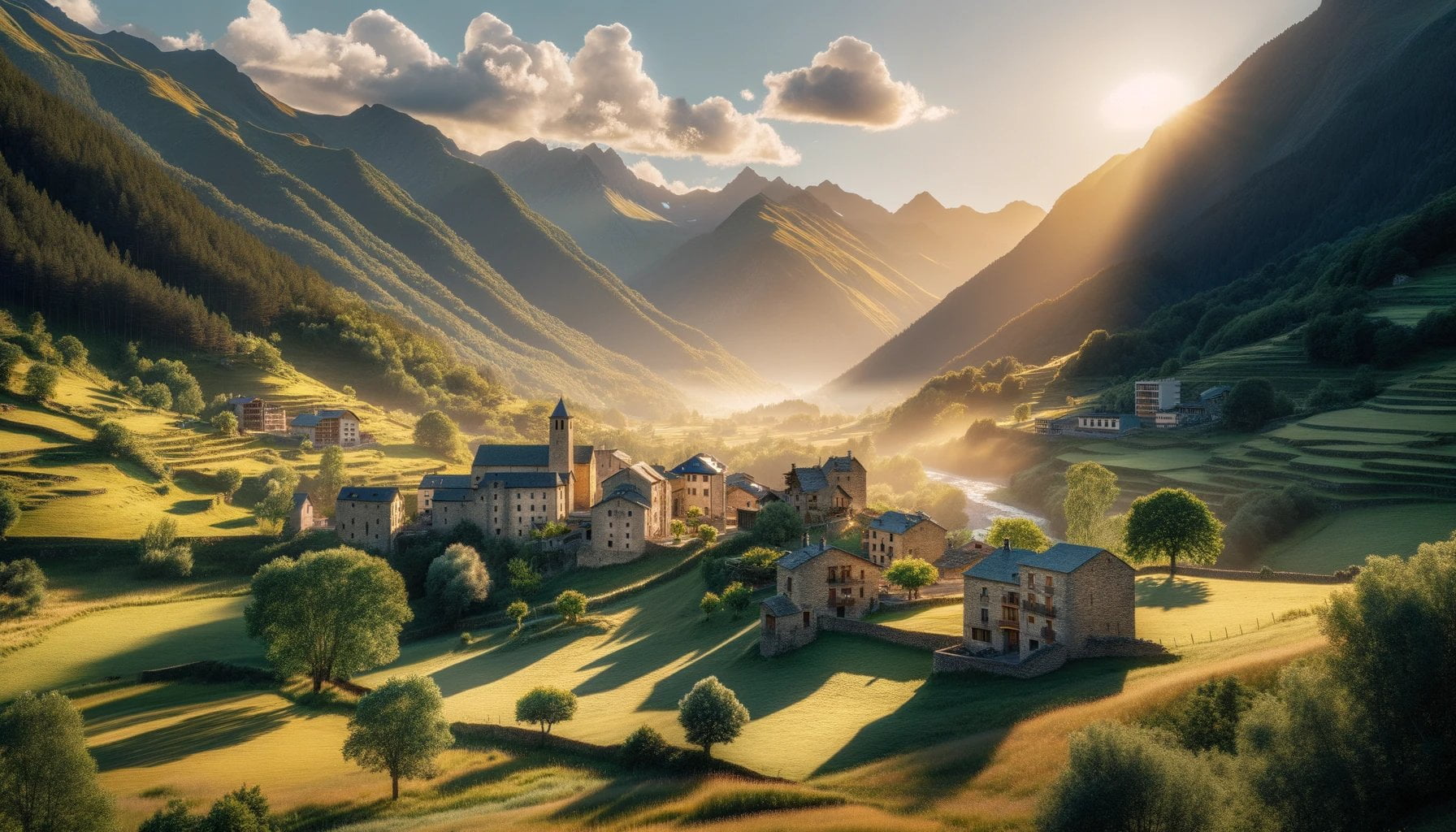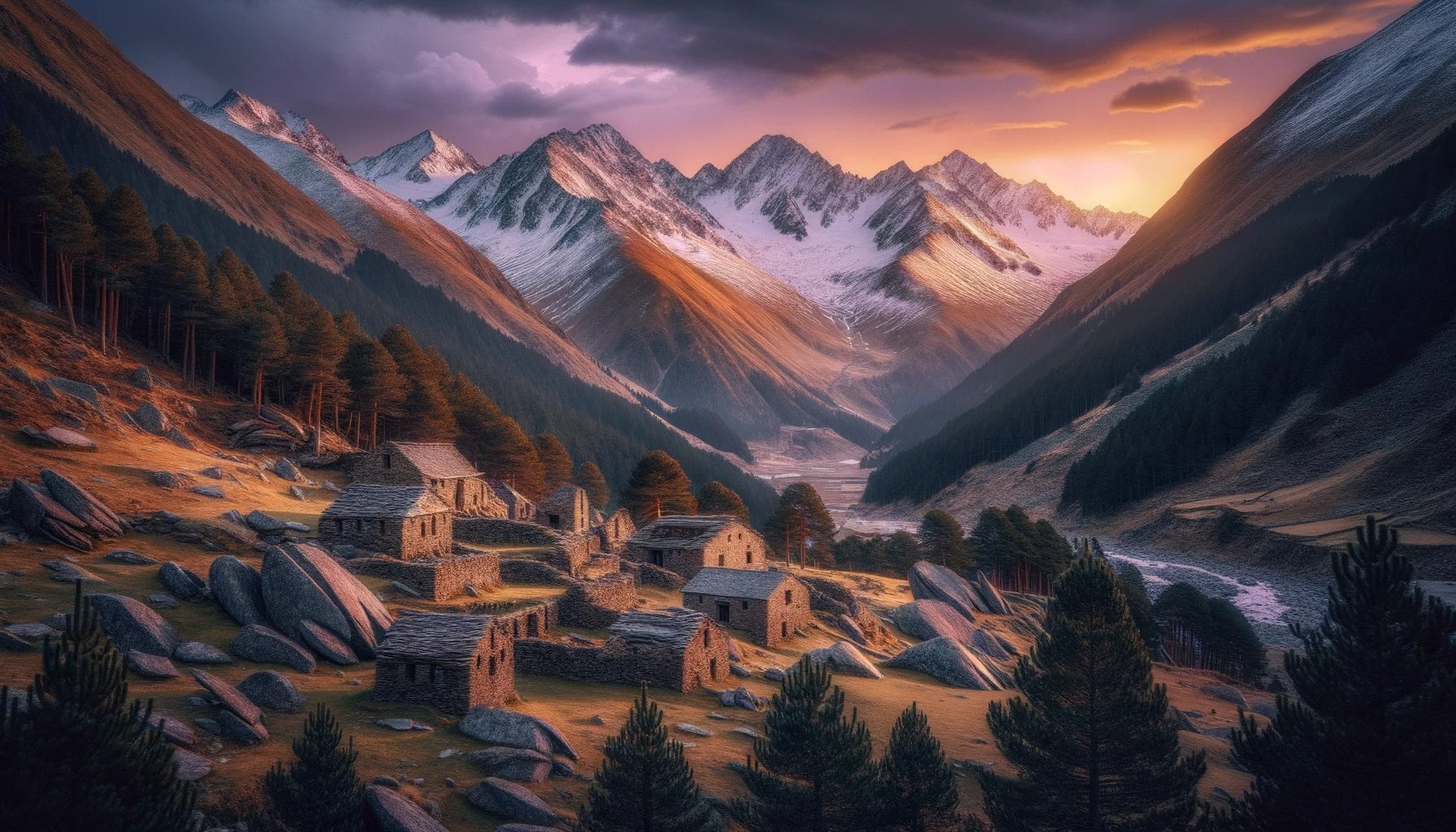Delve into the captivating history of Andorra, a hidden gem nestled in the heart of Europe. This enchanting nation, steeped in medieval allure, boasts a wealth of untold stories waiting to be unearthed. As we embark on a journey through time, we will explore the intricate tapestry of Andorra’s medieval past, uncovering the intriguing tales of its people, the momentous events that shaped its destiny, and the remarkable cultural heritage that still thrives today. Prepare to be transported to a realm where knights roamed, castles stood proud, and legends were born, as we offer a glimpse into the captivating medieval history of Andorra.
Key Takeaways:
- Andorra is a sovereign landlocked microstate located in Southwestern Europe, bordering Spain and France.
- It is believed to be the last independent survivor of the Marca Hispanica, created by Charlemagne to defend Christian France against the advancing Islamic Moors.
- Charlemagne granted a charter to the Andorran people, establishing their independence as a buffer state.
- Andorra did not officially participate in World War I, but had three Andorran volunteers who fought in the conflict.
- Claims that Andorra declared war on Germany in 1914 are unsubstantiated.
- France occupied Andorra in 1933 due to social unrest, and Andorra carried out its first execution since the 19th century in 1943.
- After World War II, Andorra experienced prosperity through the development of its tourism industry.
- In 1993, Andorra transitioned to a parliamentary democracy with reduced powers for the co-princeship.
- Andorra joined a customs union with the European Communities, became a member of the United Nations and the Council of Europe, and established diplomatic relations with other nations.
- Andorra focuses on improving its export potential and increasing economic ties with European neighbors, particularly through its financial services sector.
Andorra History

Andorra, known officially as the Principality of Andorra, is a fascinating microstate in Southwestern Europe. Its history is a captivating tale that spans centuries and is filled with intriguing events and remarkable figures. Let’s dive into the rich history of Andorra, from its origins to its modern-day developments.
Charlemagne and the Moors
Legend has it that Andorra’s independence as a buffer state was established thanks to Charlemagne. In return for the Andorran people’s assistance in fighting against the Moors, Charlemagne granted them a charter. This charter is believed to be the foundation of Andorra’s independence and its unique position as the last surviving independent state of the Marca Hispanica. It’s a testament to the bravery and resilience of the Andorran people.
World War I and 20th-century Developments
While Andorra didn’t officially participate in World War I, it had three brave volunteers who fought in the conflict. And although there were claims in North American newspapers in 1958 that Andorra had declared war on Germany in 1914, no contemporary evidence supports this claim. In 1933, France occupied Andorra due to social unrest, and in 1943, Andorra carried out its first execution since the 19th century.
After World War II, Andorra experienced a period of prosperity fueled by the development of its tourism industry. The country worked hard to improve its infrastructure and transportation, effectively breaking down its isolation and becoming an integral part of European history. The 1970s and 1980s marked a significant turning point, with the extension of the franchise to women and the creation of more autonomous organs of government in response to public demands for democratic reforms.
Political Developments and International Relations
In May 1993, Andorra transitioned to a parliamentary democracy through a popular referendum that approved a new constitution. This constitution retained the co-principality, although with reduced powers, and introduced expanded civil rights, including the legalization of political parties and an independent judiciary. Andorra also became a member of the United Nations in 1993 and the Council of Europe in 1994, establishing diplomatic relations with other nations like the United Kingdom and the United States.
Andorra’s focus has been on improving its export potential and fostering economic ties with its European neighbors. The financial services sector plays a significant role in the country’s economy, thanks to its tax haven status and banking secrecy laws. These developments have propelled Andorra into the global arena, allowing it to thrive while retaining its unique identity.
Conclusion
Andorra’s history is a tapestry woven with bravery, independence, and remarkable transformations. From its origins as a buffer state to its modern status as a prosperous microstate, Andorra has come a long way. The story of Andorra’s captivating past is a testament to the resilience and determination of its people. Journey through the pages of history and discover the remarkable narratives and events that have shaped this extraordinary nation.
Read more: Wikipedia – History of Andorra /
Encyclopedia Britannica – Andorra
If you’re curious about the fascinating facts about Andorra, click here to explore more about this charming country nestled in the Pyrenees Mountains.
Discover the enchanting world of tourism in Andorra by clicking here. From stunning natural landscapes to thrilling outdoor activities, Andorra has something for everyone.
Immerse yourself in the rich Andorran culture by clicking here. From traditional festivals to vibrant music and dance, Andorra’s culture is sure to captivate and inspire.
Uncover the hidden gems and famous places in Andorra by clicking here. From ancient Romanesque churches to iconic ski resorts, there’s no shortage of remarkable sights to visit.
Indulge your taste buds with the delicious cuisine of Andorra by clicking here. From hearty mountain dishes to exquisite Catalan influences, Andorra offers a delectable gastronomic experience.
Unearthing Andorra’s Enthralling Medieval History
Key Takeaways:
- Andorra’s independence can be traced back to Charlemagne, who liberated the region from Muslim control in 803.
- The strategic importance of Andorra is highlighted by its role as a buffer state created by Charlemagne to protect Christian France from advancing Islamic Moors.
- Modern-day Andorra enjoys a thriving tourism industry and serves as a tax haven, contributing to its economic prosperity.
- Andorra follows a unique political system as a parliamentary coprincipality, with the Archbishop of Urgell and the President of the Republic of France serving as the heads of state.
Imagine walking through the stunning landscapes of Andorra, surrounded by panoramic views of the Pyrenees Mountains and picturesque valleys. As you explore this captivating land, it’s essential to understand the historical tapestry that has shaped the nation we know today. Let’s embark on a journey through Andorra’s medieval history, a story filled with intriguing tales of independence, strategic significance, and cultural evolution.
The Origins of Andorra’s Independence
Andorra’s independence can be traced back to the legendary Emperor Charlemagne. In 803, Charlemagne reconquered the region from the Muslims, and as a token of gratitude for their assistance in the fight against the Moors, he granted the inhabitants a charter of liberties. This act marked the beginning of Andorra’s independent spirit and its unique historical path.
A Buffer State Created by Charlemagne
Beyond its independence, Andorra holds the distinction of being the last surviving independent territory of the Marca Hispanica, a series of buffer states established by Charlemagne to safeguard Christian France from the advancing Islamic Moors. Legend has it that Charlemagne bestowed a charter upon the Andorran people, cementing their role as defenders of Christianity. This historical context illuminates Andorra’s strategic importance and its place within the larger European medieval landscape.
From Isolation to Prosperity
While Andorra’s history includes chapters of isolation and seclusion, the country has evolved into a prosperous nation. Today, its breathtaking natural beauty and world-class ski resorts attract visitors from all corners of the globe. This influx of tourism, combined with Andorra’s status as a tax haven, has transformed it into a thriving economy with a per capita income above the European average. Improved road connections with neighboring France and Spain have further contributed to Andorra’s economic growth, creating opportunities for trade and development.
A Unique Political Structure
Andorra’s governance structure is unlike any other. It proudly carries the title of a parliamentary coprincipality, with two heads of state—the Archbishop of Urgell and the President of the Republic of France. This intriguing political arrangement originated from the historical association between the Count of Urgell and the Diocese of Urgell that dates back to Charlemagne’s granting of lands to the diocese. Underpinning this arrangement is Andorra’s first constitution, adopted in 1993, which ushered in significant changes and established executive, legislative, and judicial branches of government.
Noteworthy Facts That Unveil Andorra’s Allure
As we delve deeper into Andorra’s medieval history, it’s essential to appreciate some noteworthy facts that further illustrate the country’s allure:
- Andorra boasts one of the highest life expectancies in the world, with an average of 82.9 years at birth.
- Despite its small size, Andorra possesses a vibrant cultural heritage, blending influences from its Spanish, French, and Catalan neighbors.
- The country’s duty-free shopping has made it an attraction for tourists seeking affordable luxury goods.
Through these fascinating historical narratives, we gain a glimpse into Andorra’s captivating past, shaped by its strategic importance, unique political structure, and thriving economy. From Charlemagne’s role in establishing Andorra’s independence to its transformation into a prosperous nation, this small European coprincipality offers a rich tapestry of history and culture for us to explore and appreciate.
Sources:
- Encyclopedia Britannica: Andorra: geography, history, and system of government
- Wikipedia: History of Andorra
Uncovering Andorra’s Captivating Past: A Glimpse into its Medieval History
Andorra, a small sovereign microstate nestled in the eastern Pyrenees mountains, holds a captivating history that is often overshadowed by its stunning natural landscapes. As an experienced historian specializing in European medieval history, I have delved into the archives to uncover the lesser-known aspects of Andorra’s past. Join me on a journey through time as we explore the socio-political dynamics, cultural evolution, and significant events that have shaped this remarkable nation.
The Origins: A Buffer State in Charlemagne’s Empire
Andorra claims its origins as the last independent survivor of the buffer states created by Charlemagne in the 9th century. Charlemagne established these states to protect Christian France from the Islamic Moors. Under Charlemagne’s decree, the Count of Urgell was appointed the overlord of Andorra, granting the region its initial independence.
Disputes, Power Struggles, and Sovereign Agreements
In the 11th century, a dispute arose between the Occitan Count of Foix and the Catalan bishop over Andorra. The Bishop of Urgell sought protection from the Lord of Caboet, leading to an intricate power struggle. Eventually, in 1278, a pareage agreement was signed, sharing sovereignty over Andorra between the Count of Foix and the Bishop of La Seu d’Urgell.
Throughout history, Andorra faced periods of annexation. It was briefly incorporated into the Crown of Aragon in both 1396 and 1512, further influencing its cultural and political landscape.
Andorra’s Role in Major Conflicts and World War Connections
While Andorra did not officially participate in World War I, three brave Andorran volunteers joined the conflict. However, it is worth noting that claims of Andorra declaring war on Germany in 1914 and signing a peace treaty in 1958 lack contemporary evidence.
Social unrest in Andorra led to a brief occupation by France in 1933, just before elections took place. Amid the turmoil, an adventurer even declared himself the sovereign prince of Andorra in 1934, but was swiftly arrested.
During World War II, Andorra remained neutral. However, its strategic geographical location made it an important smuggling route during the conflict.
Social, Political, and Cultural Shifts
Post-World War II, Andorra’s developing tourist industry brought prosperity and broke its isolation. The nation experienced an influx of visitors, which served as a catalyst for economic growth and cultural exchange.
Democratic reforms in the 1970s responded to public demands and led to extending the franchise to women. These reforms also created more autonomous organs of government, further shaping Andorra’s political landscape.
In May 1993, Andorra achieved a significant milestone by transitioning to a parliamentary democracy. Under this new political framework, Andorra retained the French and Spanish co-princes, although with reduced powers, and made improvements in civil rights. This transition also marked Andorra’s membership in international bodies such as the United Nations and the Council of Europe.
Key Takeaways:
- Andorra’s medieval history is rooted in its establishment as a buffer state by Charlemagne in the 9th century.
- Disputes and power struggles shaped Andorra’s sovereignty, ultimately resulting in a pareage agreement between the Count of Foix and the Bishop of La Seu d’Urgell in 1278.
- Annexations by the Crown of Aragon in the 14th and 16th centuries influenced Andorra’s cultural and political landscape.
- Andorra remained neutral during major conflicts, including World War I and World War II, but played a role in terms of volunteers and strategic smuggling routes.
- Post-World War II, Andorra’s tourist industry brought prosperity and broke its isolation.
- Democratic reforms in the 1970s and 1980s, including extending the franchise to women, responded to public demands.
- In May 1993, Andorra transitioned to a parliamentary democracy, retaining the French and Spanish co-princes with reduced powers while improving civil rights.
Sources:
– Wikipedia on Andorra
– Andorra Insiders
Unveiling Andorra’s Fascinating Medieval History
Key Takeaways:
- Andorra’s independence as a buffer state was established thanks to Charlemagne in return for their assistance against the Moors.
- France occupied Andorra in 1933 due to social unrest and Andorra carried out its first execution since the 19th century in 1943.
- After World War II, Andorra experienced prosperity through the development of its tourism industry.
- In the 1970s and 1980s, Andorra extended the franchise to women and created more autonomous organs of government in response to public demands.
- In 1993, Andorra transitioned to a parliamentary democracy and became a member of the United Nations and the Council of Europe.
Andorra, officially known as the Principality of Andorra, is a captivating microstate tucked away in the eastern Pyrenees mountains of Southwestern Europe. This sovereign landlocked nation shares its borders with Spain and France, revealing a rich historical tapestry that unravels the story of its unique development and endurance over the centuries.
Carving a Buffer State in the Face of Adversity
Let’s dive straight into the heart of Andorra’s medieval history, where we find the origin of its independence and autonomy. Charlemagne, the esteemed Emperor of the Carolingian Empire, played a significant role in shaping Andorra’s destiny. Back in the 9th century, Charlemagne created a buffer state known as the Marca Hispanica to safeguard Christian France from the relentless advances of the Islamic Moors. Andorra claims the esteemed title of being the last independent survivor of the Marca Hispanica.
The Charter and the Shared Sovereignty
In recognition of Andorra’s loyalty and assistance against the Moors, Charlemagne granted the Andorran people a charter. This momentous charter sealed Andorra’s sovereignty, introducing a unique concept of shared power. In 1278, a consequential pareage agreement was signed, dividing Andorra’s sovereignty between the Count of Foix and the Bishop of La Seu d’Urgell from Catalonia. This shared arrangement is a testament to the intricate socio-political dynamics that defined Andorra’s development.
Annexation and Occupation: The Turbulent Tides
Andorra’s historical journey was not without its share of challenges. The Crown of Aragon briefly annexed Andorra twice, first in 1396 and then in 1512. These episodes of annexation left their imprint on Andorra’s cultural and political landscape, introducing new influences and perspectives.
In 1933, France occupied Andorra in response to social unrest preceding elections. This occupation may have disrupted daily life, but it also contributed to Andorra’s intricate narrative.
Resilience and Unique Endeavors
Andorra’s remarkable history is intertwined with countless stories of resilience and unique endeavors. An adventurer by the name of Boris Skossyreff briefly declared himself the sovereign prince of Andorra in 1934, igniting a conflict with the Bishop of Urgell. Although his reign was short-lived, this fascinating episode sheds light on Andorra’s captivating past.
During World War II, Andorra chose a path of neutrality, offering a critical smuggling route from Spain to France. Andorra’s involvement may have been minimal in major conflicts, but it played a discreet yet essential role during this tumultuous period.
Embracing Change and Transition
In the wake of World War II, Andorra experienced a remarkable transformation. The blossoming tourism industry brought prosperity and cultural exchange, shaping the present-day landscapes of this enchanting nation. The demands for democratic reforms in the 1970s led to an extensive extension of the franchise to women and the creation of more autonomous organs of government in the 1980s.
The year 1993 marked a pivotal moment in Andorra’s history. It officially transitioned into a parliamentary democracy, solidifying its path towards self-governance. Andorra’s membership in international bodies such as the United Nations and the Council of Europe attests to its growing influence in the global arena.
As we navigate through the annals of Andorra’s captivating past, it becomes evident that this nation’s enduring spirit and journey through time are stories worth cherishing. The intricate blend of cultural influences, dynamic political shifts, and remarkable individuals have shaped Andorra into the remarkable country it is today.
Citations:
1. History of Andorra – Wikipedia

FAQ
Q1: What is the official name of Andorra?
A1: The official name of Andorra is the Principality of Andorra.
Q2: Where is Andorra located?
A2: Andorra is located in Southwestern Europe, nestled in the eastern Pyrenees mountains. It is bordered by Spain and France.
Q3: What is the historical significance of Andorra’s independence?
A3: Andorra’s independence is traditionally attributed to Charlemagne, who recovered the region from the Muslims in 803. The Andorran people were granted a charter of liberties in return for their assistance in fighting against the Moors.
Q4: What is the governance structure of Andorra?
A4: Andorra follows a unique political system as a parliamentary coprincipality. It has two heads of state – the Archbishop of Urgell and the President of the Republic of France. The country adopted its first constitution in 1993, which established executive, legislative, and judicial branches of government.
Q5: How did Andorra transform from isolation to prosperity?
A5: After World War II, Andorra experienced considerable prosperity through the development of its tourism industry. The country improved its infrastructure and transportation, breaking down its isolation and bringing it into the mainstream of European history.
“`json
“`
- Unlock 6000+ words beginning with he: A comprehensive analysis - April 20, 2025
- Mastering -al Words: A Complete Guide - April 20, 2025
- Master Scrabble: High-Scoring BAR Words Now - April 20, 2025
















